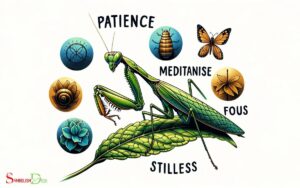What Is the Symbolic Meaning of a Dandelion? Resilience!
The dandelion symbolizes various profound concepts such as hope, resilience, transformation, and the fulfillment of desires.
Its widespread presence across cultures adds layers to its symbolism, making the dandelion a versatile emblem in literature, art, and spiritual practices.
The dandelion, a plant that thrives in challenging conditions, is often associated with the ability to rise above life’s challenges.
The symbolic meanings attributed to the dandelion include:
- Hope and Resilience: The dandelion’s growth in difficult environments symbolizes the ability to persist through hardship.
- Transformation: As the dandelion transforms from a yellow flower to a white puffball, it represents change and growth.
- Wishes and Dreams: The tradition of blowing dandelion seeds into the air while making a wish ties the plant to the concept of dreams coming true.
- Healing Properties: In various cultures, the dandelion’s medicinal qualities symbolize healing and emotional well-being.
Dandelions remind us of nature’s cycle of growth and renewal, symbolizing new beginnings and the resilience to overcome adversity.
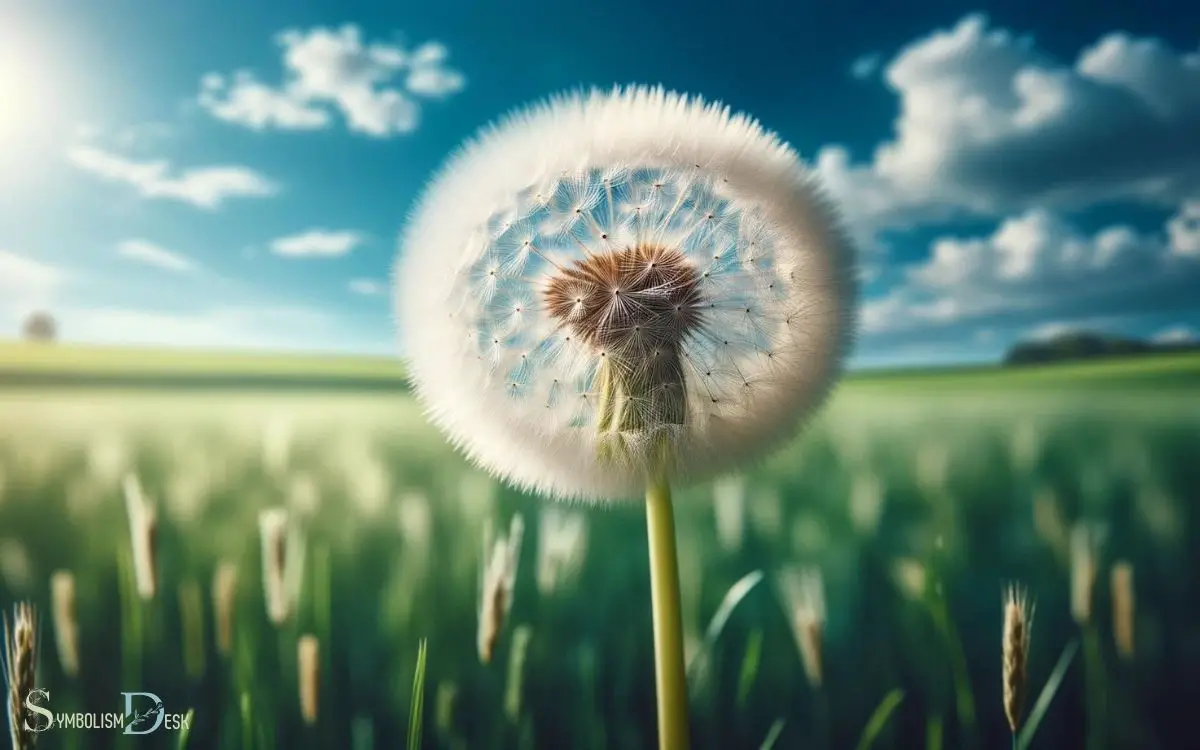
Key Takeaway
The Dandelion’s Resilience
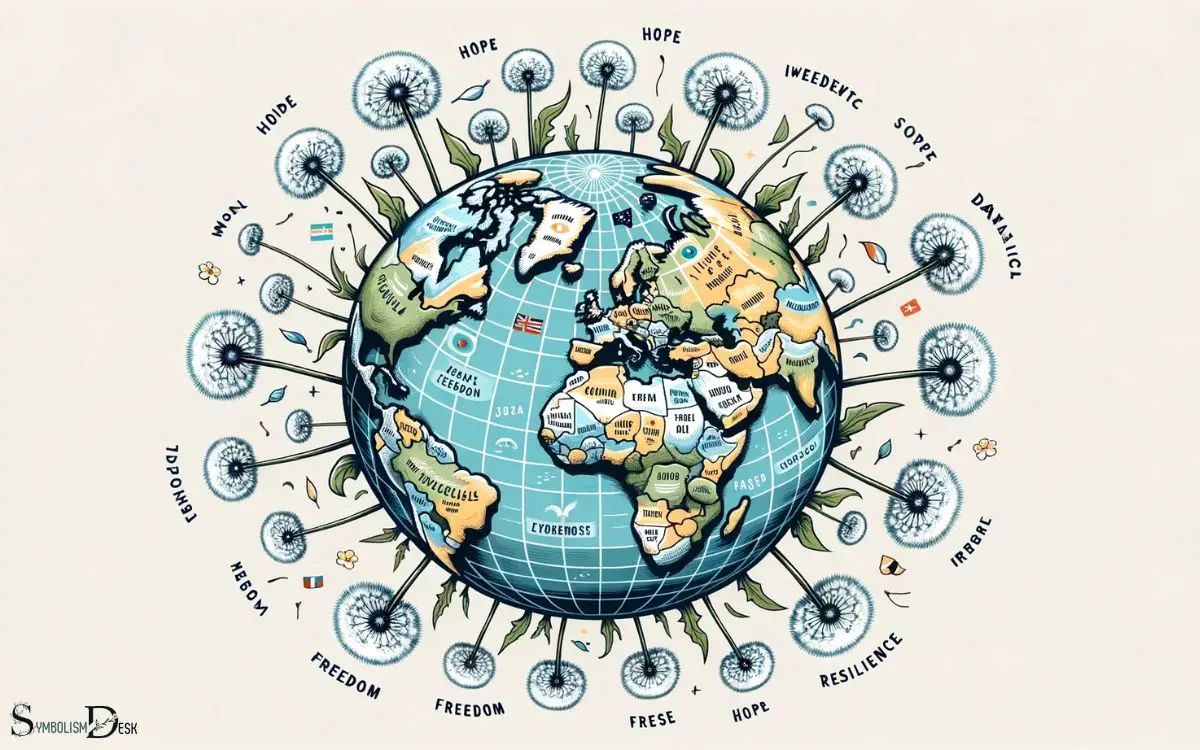
The dandelion thrives in spite of adversity and hardship, making it a symbol of resilience in nature. Its ability to grow in harsh conditions and spread its seeds with the slightest breeze showcases its tenacity.
Despite being labeled as a weed, the dandelion continues to bloom brightly, undeterred by efforts to eradicate it. This resilience mirrors the strength and determination seen in individuals who overcome challenges.
The dandelion’s deep taproot allows it to withstand drought and other unfavorable conditions, demonstrating its remarkable ability to adapt and survive. This resilience has made the dandelion a powerful symbol of hope and perseverance.
Understanding the dandelion’s resilience sheds light on its cultural significance and the various meanings it holds in different societies.
Cultural Significance of Dandelions
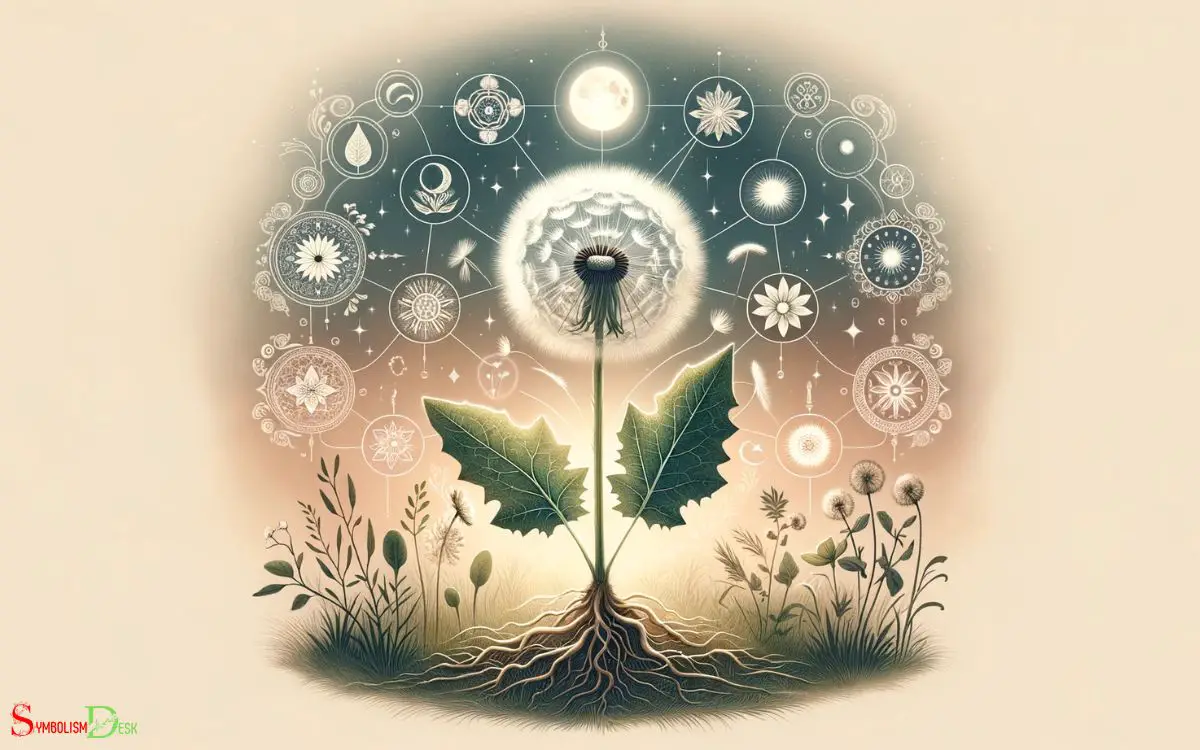
Dandelions have held cultural significance in various societies for centuries. They often feature prominently in folklore and superstitions. In many cultures, blowing the seeds of a dandelion while making a wish is believed to bring good luck and grant one’s desires.
Understanding the dandelion’s cultural significance can provide insight into the enduring impact of this humble yet resilient plant.
Dandelion in Folklore
In many cultures, the dandelion holds significant symbolic meaning, reflecting its widespread presence and impact on folklore and traditions worldwide.
One of the most common beliefs about dandelions is that blowing the seeds off a dandelion head will carry your thoughts and dreams to loved ones when they’re scattered by the wind.
In European folklore, the dandelion is associated with the idea of oracle and divination. Its yellow blossoms are said to indicate the arrival of fair weather, while the white puffball of seeds suggests the approach of rain.
In Asian cultures, the dandelion is often used as a symbol of perseverance and strong will due to its ability to thrive in harsh conditions.
In Native American folklore, the dandelion is seen as a gift from the sun, carrying the warmth and energy of the celestial body.
Dandelion as a Wish
Associated with hope and desires, the dandelion’s significance as a wish transcends cultural boundaries, embodying the universal human longing for fulfillment and positivity.
In various cultures, the act of blowing dandelion seeds while making a wish is a widespread practice. This tradition reflects the belief that the dandelion possesses the power to carry messages and fulfill wishes.
The dandelion’s transformative life cycle, from a vibrant yellow flower to a delicate seed dispersal, parallels the journey of wishes and dreams.
This symbolism has been embraced in many societies, where people see the dandelion as a symbol of hope and the potential for wishes to come true.
Whether used in rituals or as a simple act of hope, the dandelion’s role as a wish reflects the enduring human desire for optimism and fulfillment.
Dandelion Symbolism in Different Regions
Throughout various regions around the world, dandelions hold diverse symbolic meanings and cultural significance.
In Eastern Asia:
- In China, the dandelion is seen as a symbol of perseverance and survival. Its deep root and ability to thrive in harsh conditions make it a metaphor for overcoming adversity.
- In Japan, the dandelion is associated with transience and the fleeting nature of life. It’s often depicted in art and literature as a representation of the beauty of impermanence.
Dandelion symbolism varies widely, reflecting the unique perspectives and values of different cultures. Understanding these diverse interpretations enhances our appreciation for the interconnectedness of human experiences.
Dandelion’s Representation of Transformation
The dandelion’s representation of transformation is a significant aspect of its symbolic meaning. It symbolizes resilience and adaptability, as its seeds disperse easily and take root in diverse environments.
The dandelion’s life cycle, from golden flower to delicate seed head, represents the constant process of change and growth.
Dandelion as Symbol
Dandelions symbolize transformation into something new and different from their humble beginnings. They serve as a powerful symbol of change and growth, representing the journey from a simple weed to a resilient and beautiful flower.
To understand the symbolic meaning of dandelions as a representation of transformation, consider the following:
- Resilience: Dandelions can thrive in challenging environments, symbolizing the strength and resilience needed to undergo transformation.
- Adaptability: Their ability to adapt and spread widely reflects the resilience required to embrace change and transformation.
Dandelions, therefore, remind us that transformation is a natural and necessary part of life, encouraging us to embrace change and grow into something beautiful and resilient, just like the dandelion itself.
Significance in Nature
Representing transformation in nature, dandelions continue to serve as a powerful symbol of change and growth due to their resilience and adaptability.
In nature, dandelions play a significant role in ecological succession. They’re often the first plants to appear in disturbed or overgrazed areas, rejuvenating the soil and paving the way for other plant species to thrive.
This process mirrors the idea of transformation and renewal, as dandelions have the ability to turn barren landscapes into flourishing ecosystems.
Their deep taproots break up compacted soil, allowing air and water to penetrate, which in turn supports the growth of other plants.
Thus, dandelions symbolize the potential for positive change and the ability to overcome adversity, making them a powerful representation of transformation in nature.
Dandelion’s Connection to Wishes and Dreams
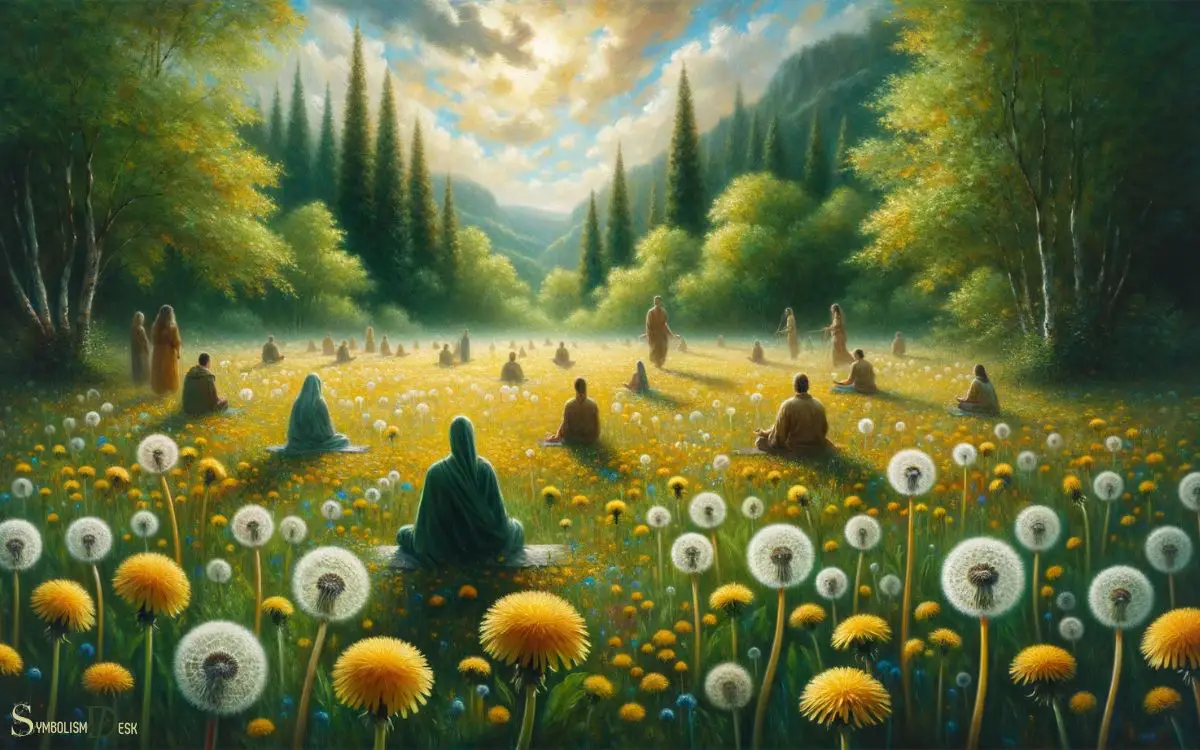
Associated with desires and aspirations, dandelions have long been linked to wishes and dreams.
- Cultural Symbolism: Across various cultures, blowing dandelion seeds while making a wish is believed to carry the wish on the wind, symbolizing hope and the granting of desires.
- Visual Representation: The dandelion’s transformation from a vibrant yellow flower to a delicate globe of seeds serves as a powerful visual metaphor for the fleeting nature of dreams and the potential for realization.
This connection to wishes and dreams has made dandelions a poignant symbol of hope and the pursuit of one’s deepest desires.
In the next section, we’ll explore the dandelion’s spiritual and metaphysical interpretations.
Spiritual and Metaphysical Interpretations
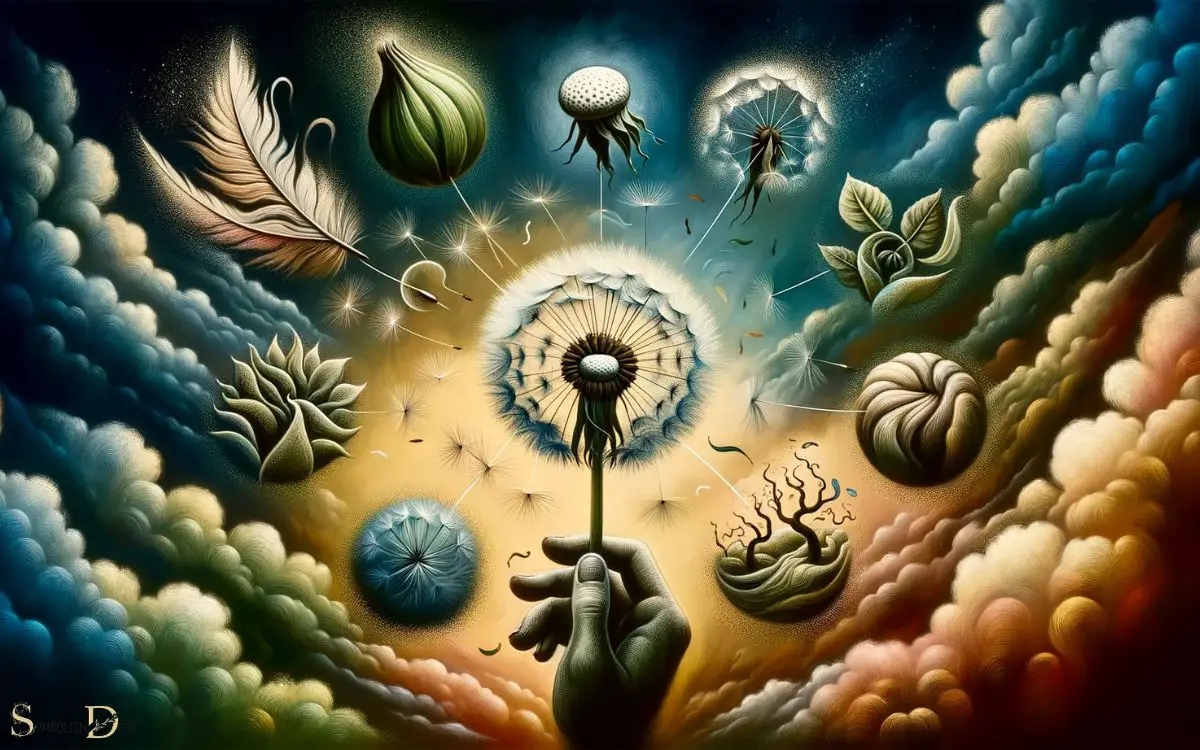
The spiritual and metaphysical interpretations of the dandelion build upon its symbolic connection to wishes and dreams, delving into deeper layers of meaning and significance.
In various spiritual beliefs, the dandelion is seen as a symbol of spiritual growth, resilience, and the ability to overcome challenges. Its yellow color is associated with the solar plexus chakra, representing personal power and self-expression.
Metaphysically, the dandelion is believed to carry the essence of the sun, embodying energy, vitality, and transformation. Its ability to spread seeds far and wide is often seen as a representation of manifestation and the interconnectedness of all living beings.
Many view the dandelion as a reminder to embrace change, release emotional baggage, and foster inner strength to achieve one’s highest potential.
The Dandelion’s Role in Modern Symbolism
In modern symbolism, dandelions frequently symbolize resilience and adaptability, reflecting the plant’s ability to thrive in diverse environments. This has led to their representation of overcoming challenges and standing strong in the face of adversity.
In addition to their symbolic meaning of resilience, dandelions also hold significance in modern culture as a representation of the fleeting nature of life and the importance of seizing the moment.
This is often associated with the plant’s transformation from a vibrant yellow flower to a delicate white puffball, dispersing its seeds with the wind.
The dandelion’s role in modern symbolism also extends to themes of growth and potential, as it’s often used to convey the idea of embracing change and pursuing personal growth.
Conclusion
The dandelion’s symbolic meaning transcends cultures and time, representing resilience and transformation. The dandelion’s symbolic meaning transcends cultures and time, representing resilience and transformation. Its delicate seeds, carried by the wind, symbolize both fragility and the potential for new beginnings. Similarly, the symbolic meaning of the shattered conch in literature often underscores themes of lost order and the unraveling of societal structures, contrasting the dandelion’s hopeful promise with a darker narrative of collapse. Through these symbols, nature and objects alike become vessels for profound human emotions and reflections.
Like the dandelion’s ability to thrive in harsh conditions, it serves as a metaphor for the human spirit’s resilience in the face of adversity.
Just as its delicate seeds disperse in the wind, the dandelion symbolizes the power of wishes and dreams taking flight, reminding us to embrace change and embrace the unknown. Like a field of dandelions dancing in the breeze.





